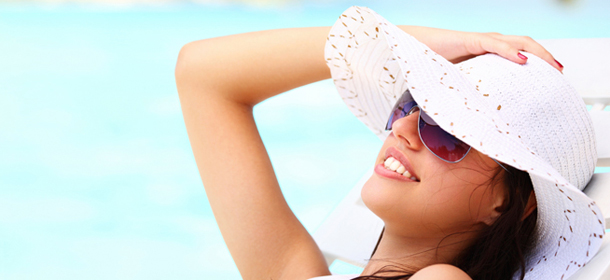With the following sun protection advice your can easily prevent sunburn and skin cancer to enjoy summer safely without regret.
Prevent skin cancer by preventing sunburn
Tanning is still in trend, however, a responsible exposure is the key to avoid sunburn and skin cancer. Each year, besides the increasing number of new cases, patients are diagnosed for skin cancer increasingly at younger people. Therefore, the right protection against the main exogenous risk factor remains crucial to avoid this burden.
Prevent skin cancer – tips for sun protection
In general, there are 2 kinds of skin cancer: melanoma and non-melanoma skin cancer.
Melanoma
Melanoma is the most dangerous type of skin cancer as it can spread to distant parts of the body even if it is removed completely. It can emerge on any part of the body, even on sites that are not regularly exposed to the sun. Most frequently, melanomas arise on the trunk such as the back and, particularly for women, on the legs. It is therefore assumed that risk of melanoma depends on sun exposure during recreational activities rather than occupational exposure. A short but intense sun exposure such as the one leading to sunburn (e.g. on the first day at the beach) seams to be more important than a continuous exposure. Melanomas are usually dark (brown or black) and can resemble a mole at the beginning, before it starts growing.
Non-melanoma skin cancer
This is a group skin cancer, that act differently than melanomas and represents the majority of skin cancer. Mostly, a complete removal of the tumor is sufficient to avoid progression or relapse. In contrast to melanomas, Non-melanoma skin cancers are commonly found on sun-exposed areas such as the face and head, but tumors are also found on other areas. They are mostly not dark and start as a hardly visible rough alteration of the surface (like a sandpaper).
If you have any questions regarding this topic, you are welcome to read more here or to contact Dr. Okamoto’s office by filling out the contact form.
How do I protect myself against damage caused by the sun?
Sun protection is composed of several measures not just one:
- use of sun creams (higher than sun protection factor 30, even in Austria)
- avoid direct sun exposure longer than 10 minutes between 11am and 4pm in warmer climates (e.g. meditranean sea, southeast asia, Maledives, etc.).
- wear clothes with long sleeves and hats with brims. In hotter climates, textiles need to be adjusted to the temperature but if you cannot find a shade this is required to avoid damage caused by the sun.
It is important to note that this information is not meant to keep you away from out door activities but the key is to avoid excessive sun exposure (even unintended) leading to health hazards. Therefore, for example finding a shady place for any kind of activities will already help you to spare you a painful experience with long term damage.
What are long-term signs of excessive sun exposure?
Besides the acute signs of excessive sun exposure, there are several signs of sun damage such as wrinkling and freckles. In a study conducted in Vienna, we could show that particularly those appearing on the back are strongly associated with skin cancer. These signs are easily detected and can be regarded as a good indicator of risk.
Tanning before you go on vacation – a common misbelieve
Last but not least, it is a common misbelieve that tanning before you go on vacation protects you from the sun. It is much more reasonable to save your time and money for a good sun protection to use it when you need it. Remember: sun beds have been shown to increase risk for skin cancer!
Please go to Skin cancer treatment in Vienna for further information on early recognition, diagnosis and treatment of skin cancer. Dr. Okamoto is specialized on the diagnosis and treatment of any type of skin diseases. To set an appointment, please fill out the electronic form. You will be contacted shortly.
Contact Prof. Dr. Okamoto
For appointments, please contact us by phone +43 1 40114/5701, 5702 or 5703, or via E-Mail at ordination@hautarztokamoto.at or contact form.

